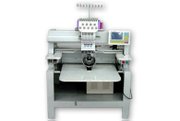IMB Show Highlights Marker-Making Advancements
Faster, quicker and stronger were the buzzwords floating around the IMB equipment show, held May 6–10 at the Koln- Messe in Cologne, Germany. More than 700 exhibitors and close to 25,000 visitors saw the latest in technology for the sewn-products industry.
The unrest in the Middle East, the continued threat of severe acute respiratory syndrome (SARS) in Asia and Canada, and the generally flat European economy cast a pall over the show, according to some exhibitors. Most conspicuous was the absence of exhibitors from China and other Asian nations, who were sidelined by issues arising from the SARS epidemic. Still, most American companies showing at IMB were pleased with the turnout and the results of the show.
“Traffic was reportedly off, and everyone felt sorry for the Asian contingent [not being here],” said Steven McLendon, president of Atlantabased Nester Software Technologies Inc. “But what was kind of surprising for us was the contacts we made with companies from Russia and the Czech Republic. We haven’t seen that before.”
Nester released NesterServer 6.0, a new version of its automated marker-making and nesting software, which the company has updated with features such as tubular markers, sectional markers, piece blocking, and construct/bump-line nesting. The company, which has a marketing agreement with Gerber Technology Inc., said businesses can download copies of the software from GerberNet, a new Web-based service.
Indeed, flexibility and speed were the primary focuses in marker-making technology at the show.
Lectra released its latest Diamino marker package at IMB. Diamino’s MarkPack module has been used for manual markermaking, which is useful for constructing complex garment pieces. Lectra updated MarkPack with a new “shaker” feature that packs all the pieces created after the manual process and generates additional material savings. Its sister module, MarkPro, now allows users to perform mixed marker-making in manual mode for complex pieces and in automatic mode for others. Other modules offer new options, such as the ability to do batch processing. Just select the different shapes to be marked, launch the system, and let it operate overnight, Lectra’s Diamino/Optiplan Range Manager Helmut Wagner said.
Wagner said Lectra has focused its product improvements on companies’ needs for quick turnarounds.
“The development and production cycles must be shortened without altering the product quality or increasing the costs—a major concern in a market subject to increasingly severe competition,” he said. “We need to promote more efficiency, savings, integration, communication and information if we are to address these new challenges.”
Tolland, Conn.–based Gerber also aimed for speed and flexibility with AccuMark V8, its latest marker-making technology. With a growing group of worldwide CAD users, Gerber chose to concentrate on flexibility with V8, which features more data-conversion capabilities. The system is compatible with industry- and customer-sponsored standards, including the new American Society for Testing and Materials (ASTM) standards, earlier American Apparel Manufacturers Association (AAMA) standards, the DXF format and the HPGL plotting standard. Gerber also equipped V8 with Microsoft SQL database compatibility, notch-positioning controls, advanced seam-allowance generation, automatic generation of seam corners, and accelerated background batch processing.
While marker-making took center stage at IMB, local companies, including Cerritos, Calif.–based Aemco Embroidery Machine Corp., focused on faster and stronger embroidery equipment.
Aemco’s Edward Chan said the company made a number of contacts and sold several automatic embroidery machines, including the Ultra 9 and the Cap-904, which are capable of storing 50,000–100,000 stitches and up to 99 designs using the latest in software technology.






















